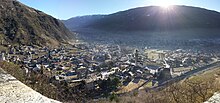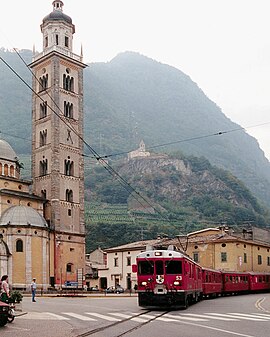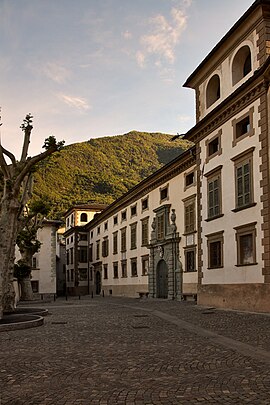Tirano
| Tirano | ||
|---|---|---|

|
|
|
| Country | Italy | |
| region | Lombardy | |
| province | Sondrio (SO) | |
| Local name | Tiràn / Tiraun ( raw ) | |
| Coordinates | 46 ° 13 ' N , 10 ° 10' E | |
| height | 441 m slm | |
| surface | 32 km² | |
| Residents | 8,986 (Dec 31, 2019) | |
| Population density | 281 inhabitants / km² | |
| Factions | Baruffini , Cologna, Madonna di Tirano, Roncaiola | |
| Post Code | 23037 | |
| prefix | 0342 | |
| ISTAT number | 014066 | |
| Popular name | Tiranesi | |
| Patron saint | San Martino ( November 11th ) | |
| Website | Tirano | |
Tirano (dt. Outdated Thiran , also: Tiran, Tyran, Tiranum, Tyranum or Tyrano Rhaeto-Romanic ) is a city and at the same time the capital of the municipality of the same name in the Italian province of Sondrio , Lombardy region with 8986 inhabitants (as of December 31 2019).
geography
Tirano is located in the Upper Valtellina at the entrance to the Poschiavo , near the Swiss border . While agriculture - especially fruit and wine growing - and local small businesses dominated in the past, some smaller industrial companies have settled here in the last few decades, but they have found it difficult to assert themselves against the competition from the regional center of Milan . That is why many Tiranesi work as day or weekend commuters in and around Milan or in the tourist resorts of the Upper Engadine .
The neighboring communities are Brusio (CH-GR), Corteno Golgi (BS), Sernio , Vervio and Villa di Tirano .
history
Early and Middle Ages
The settlement developed on the left bank of the Adda river below the Dosso castle mentioned in 1073 . In the 12th century it was first a free community, then it was subordinate to the Capitanei of Stazzona, who built the Piattamala Castle at the entrance to the Poschiavo . In 1335 Tiranos passed from Como to Milan under the rule of the Visconti , and the city became the court of the Upper Terzier of Valtellina.
In 1487 Tirano was captured by the Bündner and partially destroyed, whereupon Duke Ludovico il Moro initiated the massive expansion of the city fortifications. A curtain wall based on plans by Giovanni Francesco Sanseverino and the new St. Maria Castle were built. Nevertheless, the city was conquered again by the Graubünden in 1512, the fortifications largely destroyed and permanently taken over as subject area. Only remnants of the city gates Porta Poschiavina, Bormina and Milanese are left today. The Graubünden made a podium in Tirano and opened a cattle and goods market.
Reformation and Counter Reformation
In the 16th century Tirano developed into a center for the handling of goods and the exchange of ideas; it thus formed a hub in trade between Bünden and Venice as well as Bormio and Milan. The city was the largest in Valtellina and had around 5,000 inhabitants in 1589. A Protestant parish was established by 1560 at the latest, founded and led by Italian religious refugees such as Giulio da Milano and supported by the Graubünden. The Protestants celebrated their services with their own pastor in the Church of St. Mary. In 1597 there was a public theological disputation between representatives of both denominations.
In the vengeance of the Veltliner Murder (Italian: Sacro macello ) under the leadership of Giacomo Robustelli , the city was occupied and 60 Protestants were murdered on July 19, 1620. At the beginning of the following turmoil in Graubünden , an attempt to recapture the Graubünden people and their allies was stopped by the Spaniards in the battle of Tirano on September 11, 1620. From 1635 to 1636 Henri II. De Rohan , the Duke of Rohan, made the city his headquarters during his Alpine campaign. After the disputes ended in 1639, Tirano and the Valtellina came back to the Drei Bünde and benefited from the favorable traffic situation and the close border with the Republic of Venice .
Modern times
In 1797 the Valtellina joined the Cisalpine Republic . From 1800 onwards, Graubünden wine trading companies bought vineyards in Tirano and the surrounding area. From 1908 to 1910 the Rhaetian Railway's Bernina line , which had just been built, was connected to the Italian network.
traffic
State road 38 runs through Tirano and opens up the entire length of the Valtellina from Lake Como to the Stilfserjoch . A junction leads over the Swiss border to Poschiavo and on over the Bernina Pass into the Engadine.
Tirano has two train stations: the stazione FS of the Italian state railway FS or its subsidiary Trenord , and directly adjacent the stazione FR , the train station of the Swiss Rhaetian Railway .
The Bernina Railway operated by the Rhaetian Railway has been in service since 1908 . The Bernina Express offers direct connections from Chur and St. Moritz to Tirano. There are also regional trains that run every hour. The station also has a considerable amount of freight traffic, especially with logs imported from Switzerland and processed in Veltliner sawmills.
In the summer months, two PostBus lines run once a day to Lugano (through the Valtellina and along Lake Como, Bernina Express) as well as via Bormio and the Umbrail Pass with a detour to the Stelvio Pass to Müstair (Stelvio line) .
The city received its first rail connection on June 29, 1902. The Sondrio - Tirano line originally belonged to the private Ferrovia Alta Valtellina and was taken over by the Italian State Railways in 1970. The city can be reached with the Swiss GA travelcard.
Sights, culture and specialties
Old town
- Fortification (14th and late 15th centuries) with the three city gates Porta Poschiavina , Porta Bormina and Porta Milanese and the remains of the castle Sta. Maria (see: City fortifications of Tirano ).
- City Church of San Martino and the small Chiesa Mariano Spasmo in Via Parravichini .
- Palazzi that were built by wealthy families during the Graubünden rule
- Palazzo Salis , now the Museo Palazzo Salis , Tirano
- Palazzo Pretorio , formerly the seat of the Podestà
- Palazzo Marinoni , today the town hall with the attached church of Sant'Agostino
- Palazzo Torelli
- Palazzo Pievani and Palazzo Trombini , in the suburbs across the Adda
(see also: Palazzi in Tirano )
- above the city the ruins of the Dosso castle called Castellaccio , the former residence of the noble Omodei family.
Madonna di Tirano
The monumental pilgrimage church , the Basilica Madonna di Tirano , was built from 1505 at the place of an apparition of Mary , about one kilometer from the gates of the city , around which a second settlement core developed.
- Church with dominant tower (1578) and dome, important early Baroque painting and furnishings
- Church square with Palazzo S. Michele , formerly a monastery
- above is the little church of Sta. Perpetua in the middle of the vineyards and about 550 m as the crow flies in the direction of the Swiss border is the church of San Rocco .
Culture
- Museo Etnografico Tiranese (MET), located at the place of the pilgrimage church Madonna di Tirano.
- La libreria Il Mosaico
Culinary specialties
Tirano and its surroundings are known for their culinary (Veltliner) specialties: wine, dried meat ( bresaola ) , cheese, rye bread, pizzoccheri and other pasta.
Personalities
Sons and daughters of the town:
- Giulio da Milano (1504–1581), Protestant pastor and reformer Tiranos 1560–158
- Rudolf Paravicini (1780–1836), Colonel in the Imperial Russian Army , holder of the Order of St. Vladimir
- Carlo Braga (1889–1971), religious priest and Roman Catholic missionary
- Omobono Tenni (1905–1948), motorcycle racer
- Gian Luigi Rondi (1921–2016), film critic
- Alberto Quadrio-Curzio (* 1937), political scientist
- Valerio Righini (born August 5, 1950 in Tirano) (town Bedigliora ), painter, sculptor, graphic artist
- Marianna Longa (* 1979), cross-country skier
- Nicola Rodigari (* 1981), short tracker
- Yuri Confortola (* 1986), short tracker
- Rudy Zini (* 1988), biathlete
Other personalities
- Clemente da Brescia (* around 1640 in Brescia ; † April 28, 1703 ibid), Capuchin , publicist, guardian in the Tirano monastery
literature
- Martin Bundi : Tirano. In: Historical Lexicon of Switzerland . October 17, 2012 , accessed February 19, 2020 .
- Anna Ferrari-Bravo, Paola Colombini: Guida d'Italia. Lombardia (esclusa Milano). Milano 1987, p. 390.
- Lombardia - Touring club italiano, Touring Editore (1999), ISBN 88-365-1325-5 , Tirano Online
- Friedrich Pieth: Tirano. In: Historisch-Biographisches Lexikon der Schweiz , Volume 7, Tinguely - Hungary. , Attinger, Neuchâtel 1921, p. 1 ( digitized version ).
Web links
- Official website of the city (Italian)
- Comunità Montana Valtellina di Tirano (Italian)
- Historical recordings of the Tirano station
- Palazzo Salis
- Museo Etnografico Tiranese
- Tirano (Italian) on tuttitalia.it/lombardia
- Tirano on the ETHorama platform
Individual evidence
- ↑ Statistiche demografiche ISTAT. Monthly population statistics of the Istituto Nazionale di Statistica , as of December 31 of 2019.
- ↑ Johann Samuel Heinfius: Historical and Political-Geographic Atlas of the whole world, Edition Leipzig 1749, S. 1370. google books .
- ↑ Martin Bundi: Tirano. In: Historical Lexicon of Switzerland . 17th October 2012 .
- ↑ Santuario della Madonna di Tirano on ethorama.library.ethz.ch/de/node
- ^ Alberto Gobetti, La libreria Il Mosaico di Tirano. (Italian) at e-periodica.ch/digbib (accessed on January 15, 2017)
- ^ Adolf Collenberg: Rudolf Paravicini. In: Historical Lexicon of Switzerland . February 10, 2011 , accessed March 19, 2020 .
- ↑ Valerio Righini. In: Sikart , accessed January 11, 2016.
- ↑ Ursus Brunold: Clemente da Brescia. In: Historical Lexicon of Switzerland . February 24, 2005 , accessed February 19, 2020 .









